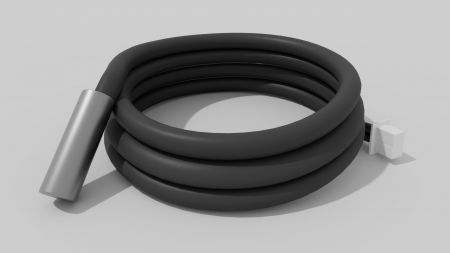Product quality standards are constantly increasing and require the use of different sensors to achieve a stable and well-controlled production process.
This article discusses:
- Types of sensors
- Temperature sensors
- Pressure sensors
- Flow sensors
- Level sensors
- Cleanability and equipment classes
- Material recommendations
- Stainless steel
- Polymeric materials
- Elastomers
- Design, geometry, and surface finish
- Process adaptation and links
- Validation of hygienic design
The experts at Dinnissen Process Technology are available to answer all your questions:
Get in touch with Juul Jenneskens 077 467 3555
Types of sensors
The working principle of sensors is to rely on an interaction with the material being processed. Therefore, the use of sensors is often associated with hygiene risks. The guideline is intended to address the potential conflict between the baseline measurement of a sensor and the optimal hygienic design. There are 4 different types of sensors:
- Temperature sensors,
- Pressure sensors,
- Flow sensors,
- Level sensors.

Types of sensors
Temperature sensors
One of the most common and important process control parameters during production and cleaning cycles is the measurement of temperatures via sensors. The most commonly used sensor elements are Pt100, NTC or PTC.
The surface temperature can be measured non-contact with optical systems. These systems evaluate the amount and distribution of infrared light emitted from the source surface.
When applying temperature sensors, the following points should be taken into account:
- Hygienic use is relatively easy, as the sensors are covered with protective covers,
- The right place for mounting the sensor is important,
- A close thermal coupling with the process is relevant,
- Thermal insulation against outside temperature is important to prevent measurement errors from ambient air, condensate or from heating or cooling jackets.

Temperature sensor
Pressure sensors
Pressure sensors can be classified into mechanical and electronic instruments. For pressure measurement in the food industry, only flush sensor systems are used to avoid dead spaces. Fluids used must be listed and comply with FDA guidelines.

Pressure sensor
Flow sensors
There are three different types of flow sensors:
- Electromagnetic flow meters. Electromagnetic flow meters can be spot cleaned with hot cleaning fluid and steam sterilized at temperatures up to 1800 ° C. The wetted parts are typically transfer molded PFA, PTFE, ceramic and stainless steel. Special considerations: the integration of the measuring electrodes in the liner should be carefully evaluated and the sealing concept between the liner and the couplings addressed
- Coriolis mass flow meters. Coriolis mass flow meters are often used in hygienic applications. Coriolis meters are generally Class I devices and can be sterilized on site (SIP). All wetted parts are usually made of suitable stainless steel or other metal pipes suitable for hygienic use.
- Variable surface flow meters. Variable surface flow meters are suitable for liquids and gases. They are relatively inexpensive, yet very accurate and reliable. The cleanability of variable surface flow meters is limited, which can compromise hygiene.
Level sensors
Some level sensors are only intended as switchgear. They indicate that a certain level has been reached or is undercut. Other level sensors are available for continuous measurement purposes, such as vibration level switches. When it comes into contact with a liquid or solids, a damping of the resonance is detected electronically. Level sensors can work without contact and are very easy to use.
Some sensors are contact controlled. These sensors can usually be evaluated based on the outside counter of their metal housing and the process connections, because the sensor element is in a protective environment.
The detailed validation of the hygienic design of a particular instrument can be a difficult task, especially for end users and system integrators
Cleanability and equipment classes
Proper design of a sensor, which is in direct contact with the product, allows on-site cleaning and can be freed from the ground without disassembly. If disassembly to clean the sensor cannot be avoided, special attention should be paid to ease of use.
Material recommendations
All parts wetted with the product must exhibit a non-toxic and inert behavior, both in relation to the product and to the cleaning fluid and disinfectants used at all pressure and temperature ranges.
Stainless steel
The choice of stainless steel type depends on the level of chlorides in the process, the required working temperature range and whether weldability of certain machining processes is important or not.
To ensure correct use of the chosen stainless steel type material certificates, according to standard EN 10204 material certificate 3.1 B should be considered.
Polymeric materials
The following criteria should be considered:
- Compatibility with the products to be processed, their ingredients and all cleaning agents used under all process conditions,
- Compliance with legal requirements and recommendations,
- CIP / SIP resistance,
- Resistance to stress cracking,
- Surface characteristics such as structure and smoothness, hydrophobicity, adsorption / desorption, reactivity, abrasion resistance and tendency to build up and release biofilms,
- Leaching,
- Resilience,
- Processing, forming, joining and packaging techniques.
Polymers commonly used in hygienically designed process equipment are:
- Polymer (POM),
- Polytetrafluoroethylene (PTFE, modified PTFE),
- Polycarbonate (PC).
Elastomers
The following criteria should be considered:
Compatibility with the products to be processed, their ingredients and all cleaning agents used under all process conditions,
- Compliance with legal requirements and recommendations,
- CIP / SIP resistance,
- Resistance to stress cracking,
- Surface characteristics such as structure and smoothness, hydrophobicity, adsorption / desorption, reactivity, abrasion resistance and tendency to build up and release biofilms,
- Leaching,
- Resilience,
- Processing, forming, joining and packaging techniques.
Compliance with FDA regulations can be covered through Food Contact Notification (FCN), certificates and declarations of conformity.
Types of elastomers that can be used:
- EPDM,
- Nitrile rubber (NR),
- Nitrile / Butyl rubber (NBR),
- Silicone rubber (RMQ).
Design, geometry and surface finish
Product contact surfaces must be free of irregularities such as gaps. This has a specific impact on the design, geometry and surface finish used in equipment such as:
- Metal joints must be continuously welded and smooth enough to allow proper cleaning,
- It is often necessary to use seals and gaskets when designing and installing sensors. These should be used so that there are no crevices where residues can be trapped and bacteria can accumulate and multiply. When the use of o-rings or gaskets cannot avoid product contact, a flat static seal on the product side should be used,
- Eliminate product contact with screw thread,
- Corners preferably have a radius equal to or greater than 6 mm; the minimum radius is 3 mm. Sharp corners (≤900) should be avoided,
- The surface roughness must be less than Ra = 0.8 micrometers.
All surfaces that come into contact with the product must be easily accessible for visual inspection or manual cleaning. Alternatively, it must be shown that routine cleaning completely removes all soil.
Process adaptation and links
If an aseptic coupling is required, EHEDG recommends using types according to DIN 11864, because these couplings are flushable.
Dairy coupling systems according to DIN 11851 are still common, as are tri-clamp, ISO-clamp (ISO 2852), SMS and IDF couplings. Tightening the coupling can overload the elastomer and cause misalignment and gaps. This can endanger hygiene.
Validation of hygienic design
The detailed validation of the hygienic design of a particular instrument can be a difficult task, especially for end users and system integrators. All necessary information may not be available and the process may be a time consuming task. A great help in validating a correct design are standardized test methods with sensor systems under specific conditions. The development of appropriate testing procedures plays an important role within EHEDG and other organizations.

Name: Juul Jenneskens
Advisor
Please feel free to contact me if you have any questions about this subject. My team of colleagues and I are ready to answer!
Get in touch with Juul Jenneskens 077 467 3555 [email protected]
Do you prefer to request a consultation directly?
